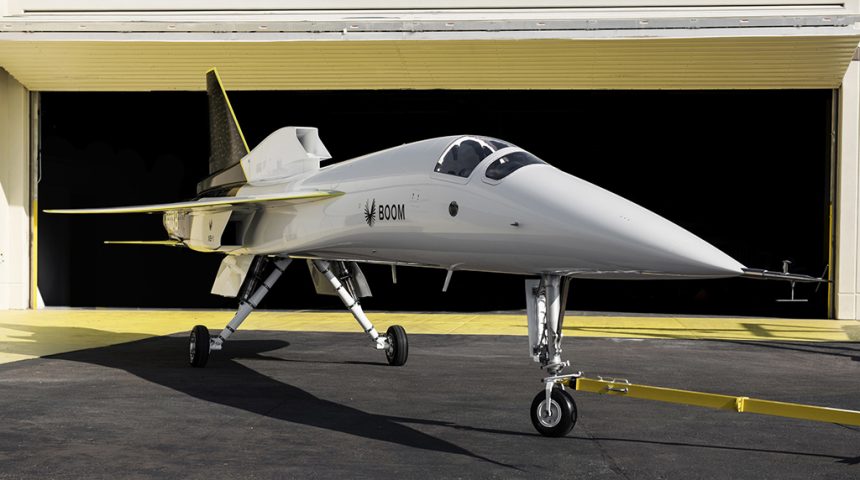Boom XB-1 Is Technology Demonstrator/Testbed for New “Low Boom” SST (supersonic transport).
The new Boom Supersonic XB-1 test aircraft was rolled out for the first time today, Wednesday, Oct. 7, 2020 at the company’s headquarters in Denver, Colorado. The aircraft, an all-composite, three-engine, delta-wing, single seat supersonic testbed is, “history’s first independently developed supersonic jet”, “slated to fly for the first time in 2021 and will undergo a 100% carbon-neutral flight test program” according to Boom Supersonic.
The Boom XB-1 is the technology testbed for the larger, low-boom, supersonic airliner project called the Boom Overture. The Overture is a proposed 45-passenger, one-class SST that would make the trip from New York to London in 3 hours, 30 minutes as compared to current subsonic airliners that can take 6 hours and 30 minutes.
Congrats to @boomaero on the rollout of its prototype for supersonic travel! The Presidential and Executive Airlift Directorate is proud to be a part of this venture and looks forward to continued exploration of ways to leverage supersonic aircraft for AF executive transport. pic.twitter.com/Tt45eWvoAc
— Air Force Life Cycle Management Center (@AFLCMCofficial) October 7, 2020
The rollout event, held mostly online, unveiled a stunningly beautiful, needle-nosed aircraft that rekindles memories of the golden age of supersonic flight testing. The XB-1 features a nose profile that mimics the 1950’s X-3 Stiletto test aircraft, remarkable, smooth delta wings and a novel three-engine configuration. It has a vaguely reminiscent cockpit profile from the UK’s abandoned BAC TSR-2 test aircraft of the late ‘50s and early ‘60s. The aircraft’s composite construction gives it a smooth, curvaceous appearance that makes first generation SST aircraft like Concorde and the Soviet-era Tu-144 look old-fashioned.
Blake Scholl, Boom Supersonic founder and CEO, told reporters today that, “Boom continues to make progress towards our founding mission—making the world dramatically more accessible”. Scholl told media that the “XB-1 is an important milestone towards the development of our commercial airliner, Overture, making sustainable supersonic flight mainstream and fostering human connection.”
But Boom Supersonic’s rollout of their XB-1 testbed comes as the world is experiencing a global pandemic with related travel restrictions that may redefine air travel in the future. Yesterday, Boeing, according to a report in the Wall Street Journal, said, “The coronavirus pandemic will reduce global jetliner demand by around 2,000 planes over the next decade as people around the world remain wary of travel”. Boeing said this will result in a reduction in sales of $200 billion throughout the aviation industry by 2029.
400+ parts. 550+ drill blocks. 180+ prototypes. All produced with 3D printing.
Boom tapped into the advantages of 3D printing throughout XB-1’s design and build. Here’s a look inside our @Stratasys F900 as it prints flight hardware, which is already installed on XB-1. pic.twitter.com/gp4gjgniy2
— Boom Supersonic (@boomaero) October 3, 2020
Prior to the COVID-19 pandemic, some sources, including The International Air Transport Association (IATA), projected that airline travel could grow substantially over the next few decades. Whether this forecast will remain in effect seems largely contingent on a medical breakthrough in controlling the global COVID-19 pandemic.
But the leading edge of aviation has always been about possibilities, not limitations, and Boom Supersonic is breaking barriers of limitations at the speed of sound with their new XB-1.
Among many innovative features on the aircraft is a high resolution, forward-facing video system that gives pilots a, “Virtual window through the nose, providing superior runway visibility for landing.” Early SSTs and supersonic test aircraft like the Concorde, Tu-144 and the XB-70 Valkyrie used a complex, moving noise section to provide the crew with forward visibility in the low-speed flight regime for take-offs and landings.
Boom Supersonic said, “After today’s rollout, XB-1 will complete its ongoing, extensive ground test program before heading to Mojave, California in 2021 for flight test. At the same time, the company will finalize Overture’s propulsion system and conduct wind tunnel tests to validate aircraft design. When XB-1 breaks the sound barrier in flight, Boom will be finalizing the design of Overture, whose own rollout is on track for 2025.”

Collaboration with the US Air Force for Government Executive Flight Program Exploration
Interestingly, Boom has also recently been awarded a contract by the Air Force under its program meant to help fund innovations with future Air Force applications. The contract will fund explorations of an Overture configuration designed for Air Force executive transport. The Department of Defense and the Air Force manage all air transport for executive branch top leadership, including Air Force One.
According to a press release issued on Sept. 8, 2020:
Overture offers the Air Force a unique combination of passenger capacity, speed, and enough space and power to accommodate the requirements of necessary mission systems. Plus, the aircraft can be configured for multiple cabin zones, affording a layout with as much privacy as necessary. Boom is designing Overture to comply with stringent FAA airworthiness and production regulations, and the aircraft will be fully adaptable to meet specific requirements for a variety of military end users.
“The United States Air Force is constantly looking for technological opportunities to disrupt the balance of our adversaries,” said Brigadier General Ryan Britton, Program Executive Officer for Presidential & Executive Airlift Directorate. “Boom is an example of the American ingenuity that drives the economy forward through technological advances. We are extremely excited to team with them as we work to shrink the world and transform the future of executive airlift.”In addition to its potential for executive transport, Overture could be adapted to satisfy other Air Force and broader Department of Defense mission requirements. Overture could also become part of the Civil Reserve Air Fleet (CRAF), enabling humanitarian and other critical airlifts in half the time









